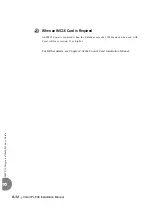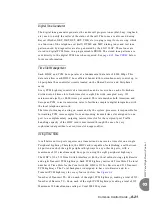
Common Control Cards
8-23
HDC C
a
rd
Hig
h
Den
sity Con
tr
o
l
8
3
The HDC card generates the audio call progress tones used to notify the caller of the
status of the call. In addition, tones used during Keyset (FlexSet, GKT, DKT, DST, EKT,
VDK, etc.) ringing (except for mute ring which is a function of the telephone set itself)
dual tone multi-frequency (DTMF) dialing tones, multi-frequency (MFC) dialing tones,
and test tone patterns used by diagnostics are also generated by the 4GC/32GC. These
tones are stored in digital PCM form, in a programmable PROM. The stored tone
patterns are output directly to the digital PCM bus when required.
Two methods of encoding audio sounds into a digital, PCM form are in common use:
The A-Law method is in common use throughout Europe, Africa, Asia, South
America, and many countries in other continents.
The
µ
-Law (pronounced M-YOO Law, sometimes spelled Mu-Law, or m-Law)
method is in common use in North America. Neither method has any particular
advantage over the other.
The Coral switching system may operate using either encoding method. The database
defaults are set to the
µ
-Law (m-Law) method for systems shipped to North America,
and A-Law for all other locations. For instructions on the database programming, see
the Program Interface and Database Reference Manual- Chapter 6 System Features (Tones,
Route: SFE, 8, M_LAW).
To operate a system using the non-default encoding method, the database must be
programmed appropriately, and the tone PROM located on the HDC card must be
changed to PROM containing the system tones stored in the appropriate encoding
method.
The encoding method is important only when the Coral system interfaces with another
switching system through a digital trunk interface card such as a T1, 30T, 30T/x, 4TBR,
8TBR, PRI-23 or PRI-30. In this case, the encoding method of both systems must match,
so that audio signals encoded by one system can be properly decoded by the other.
The integrated circuit socket U45 includes the tone PROM. See
This PROM
contains DTMF and MFC dialing tones and other system tones such as dial tone,
ringback tone, busy tone, the Keyset ringing tones. The tone PROM present in the
HDC card IC socket varies according to the country of use. The correct tone PROM for
each country of use is supplied by the manufacturer.
3
Tone PROM
Summary of Contents for Coral IPx 800 Series
Page 2: ......
Page 4: ......
Page 10: ...vi...
Page 16: ......
Page 22: ......
Page 28: ......
Page 32: ...1 4 Coral IPx 800 Installation Manual Document Description 1 NOTES...
Page 34: ...1 6 Coral IPx 800 Installation Manual Special Symbols Used in this Document 1 NOTES...
Page 40: ......
Page 48: ...2 8 Coral IPx 800 Installation Manual Site Inspection 2 NOTES...
Page 90: ......
Page 116: ...3 26 Coral IPx 800 Installation Manual Shared Service and Peripheral Card Test 3 NOTES...
Page 118: ...3 28 Coral IPx 800 Installation Manual Installation Wrap up 3 NOTES...
Page 120: ......
Page 126: ......
Page 142: ...5 16 Coral IPx 800 Installation Manual Protection Devices 5 NOTES...
Page 150: ...5 24 Coral IPx 800 Installation Manual Terminal Data Communication Ports RS 232E 5 NOTES...
Page 242: ......
Page 278: ...6 38 Coral IPx 800 Installation Manual Cage Description and Installation 6 NOTES...
Page 292: ...6 52 Coral IPx 800 Installation Manual Coral IPx 800X Expansion Cage Description 6 NOTES...
Page 312: ...6 72 Coral IPx 800 Installation Manual System Configuration Options Coral IPx 800 6 NOTES...
Page 314: ......
Page 352: ...7 38 Coral IPx 800 Installation Manual PS19 DC D Power Supply Unit with Duplication 7 NOTES...
Page 368: ......
Page 372: ...8 4 Coral IPx 800 Installation Manual Common Control Cards 8 NOTES...
Page 382: ...8 14 Coral IPx 800 Installation Manual Software Authorization Unit SAU 8 NOTES...
Page 384: ...8 16 Coral IPx 800 Installation Manual MAP 8 NOTES...
Page 386: ...8 18 Coral IPx 800 Installation Manual LIU 8 NOTES...
Page 392: ......
Page 396: ...8 26 Coral IPx 800 Installation Manual HDC Card High Density Control 8 NOTES...
Page 399: ......








































